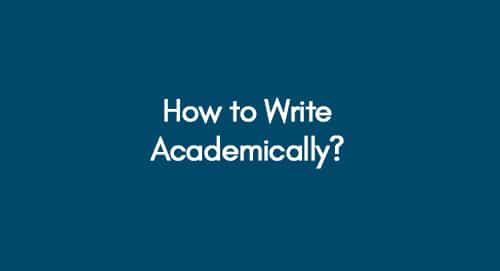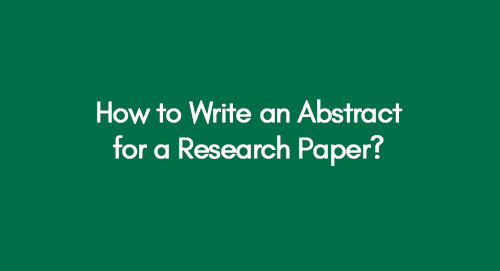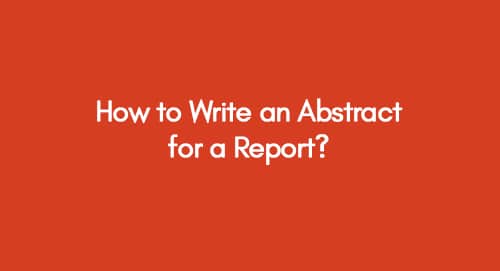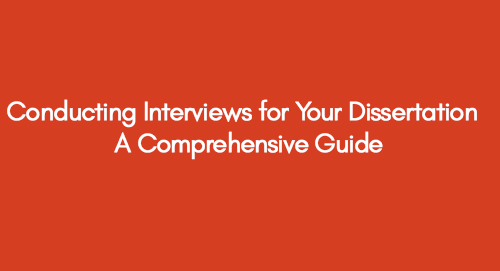
How to Write Academically: A Guide to Writing Clear, Concise, and Persuasive Writing
October 25, 2022
How to Write an Abstract for a Research Paper? | An Effective Abstract Writing
October 25, 2022Abstracts are crucial in conveying the core ideas of research papers and reports. They must be structured, concise, and precise, summarizing the document's scope and key findings. Effective abstracts aid both experts and non-experts in grasping your research quickly.
Learn More About Abstract Examples Here
Whether it's an academic report or a business summary, crafting an accurate abstract is essential. This guide teaches you how to create a report abstract that reflects your work's essence and depth.
Explore in Detail About Abstract Writing Here
If you need assistance in crafting an engaging abstract, consider hiring a professional writer with expertise in your field. Their expertise ensures your abstract effectively communicates the essential points to engage and inform your readers. Abstracts, typically 150-250 words long, should include the problem statement, study goal, and research approach, summarizing your findings' outcomes and consequences. Crafting a concise yet compelling abstract is a vital skill in effective report writing. Dive into our blog post on 'How to Write an Abstract for a Report' to learn how to capture your readers' attention.
The Main Elements of an Abstract
Abstracts often have four major components:
Purpose
Clearly state the aim and significance of your study. It also offers a description of the issue or problem.
Methodology
Methodology: Describe the investigational techniques employed to address your query.
Results
Briefly describe the key findings of the study.
Conclusion
What are the consequences of your findings, in your opinion?
Why are Abstracts Important?
Writing an abstract is important because it gives readers a quick way to assess the relevance of a paper to their research interests. Additionally, abstracts allow readers to decide whether or not they want to read the entire paper. For these reasons, authors must write clear and concise abstracts that accurately reflect the content of their documents.
How Should an Abstract be Structured?
An abstract should typically be structured as follows:
- The first sentence should state the overall aim of the paper.
- The second sentence should provide an overview of the main points covered in the paper.
- The third sentence should describe the methods that were used in the research.
- The fourth sentence should state the main findings of the research.
- The fifth sentence should discuss the implications of the findings.
What Style Should an Abstract be Written in?
An abstract should be written in a formal style. This means that it should avoid using contractions (e.g., don't, can't, won't) and personal pronouns (e.g., I, we, our). Additionally, it should be written in the third person point of view. For example, instead of saying, "I found that…" an author would say, "The study found that…".
Formatting of Abstract
Since abstracts are only used in formal papers, they are often relatively standard. Having said that, there are a few technical formats you need to be familiar with.
For consistency's sake, the American Psychological Association (APA) sets specific requirements for its articles. Here are the formatting guidelines for abstracts from the 7th edition Publication Manual:
- The text should be double-spaced.
- Page margins have to be 1 inch (2.54 cm).
- At the top of the page, capitalize "Abstract" in bold and centered.
- The first line should not be indented.
- Your abstract should not exceed 250 words.
- Include page numbers and a running header on each page, including the abstract.
3-Pass Approach for Writing an Abstract
Following these steps will aid in ensuring that your abstract is well-written and includes all the important information about your paper
1. The Three-Pass Approach
The three-pass approach is a method of writing an abstract that ensures all the important information is included. This approach involves writing the abstract in three steps: first, write a draft that includes all the essential information; second, revise the draft to ensure it is clear and concise; and third, edit the draft for grammar and punctuation. By following this approach, you can be sure that your abstract will be well-written and include all the important information.
2. Step One: Write a Draft
The first step in the three-pass approach is to write a draft of the abstract. This draft should include all the essential information about your paper, including the research question, methodology, results, and conclusions. It is important to include all this information so that you can ensure that your readers will understand what your paper is about.
3. Step Two: Revise the Draft
Once you have completed a draft of the abstract, it is time to revise it. In this step, you will read through the draft and make sure that it is clear and concise. You may need to remove some unnecessary information or reorganize some of the sentences. This step will help to ensure that your readers will be able to understand what you have written.
4. Step Three: Edit the Draft
The final step in the three-pass approach is to edit the draft for grammar and punctuation. You will reread the draft and correct any errors in this step. This step is important because it will help to ensure that your readers will be able to understand what you have written.
What is IMRaD Structure?
For scientific publications, the IMRaD format is standard. IMRaD translates to:
Introduction
You demonstrate your familiarity with the subject matter of your study and the body of prior research in the introduction. An overview of the previous research, your thesis statement, a theory (if applicable), and an explanation of the present situation should all be included in your introduction.
Method
This section should demonstrate how you used reliable, legitimate procedures to reach your conclusions. Your research, professional assistance, and what you did or did not do will all be discussed here.
Results
The findings and information you gathered should take up most of your IMRaD paper. These paragraphs ought to be worded succinctly and factually.
Discussion
In this chapter, you should go over the findings of the study or project, compare them to those of other studies, consider if more research is necessary, and offer suggestions that may be implemented.
Tips for Writing an Effective Abstract
- Don't exceed the word limit. A typical abstract is between 100 and 250 words.
- Observe the formatting specifications for your abstract.
- Instead of stating what the paper will inquire about or examine, describe what it discovered.
- List essential terms and create one or two sentences that sum up each chapter or part. Utilize this as a foundation while you construct your abstract.
- Use keywords throughout your abstract so that readers can easily find your paper when searching for relevant literature.
- Ensure all the information in your abstract is also present in your full paper.
- Proofread your abstract before submitting it for publication to ensure no errors or typos.
Things to Avoid
- A lot of references to other works
- Any concepts being defined
- Including details that aren't present in the main work
- Adding pointless language and extraneous filler words
This is how to style and how to write an abstract for a post. Following these detailed guidelines and techniques will make you an incredible report writer.
Get 3+ Free Dissertation Topics within 24 hours?


























